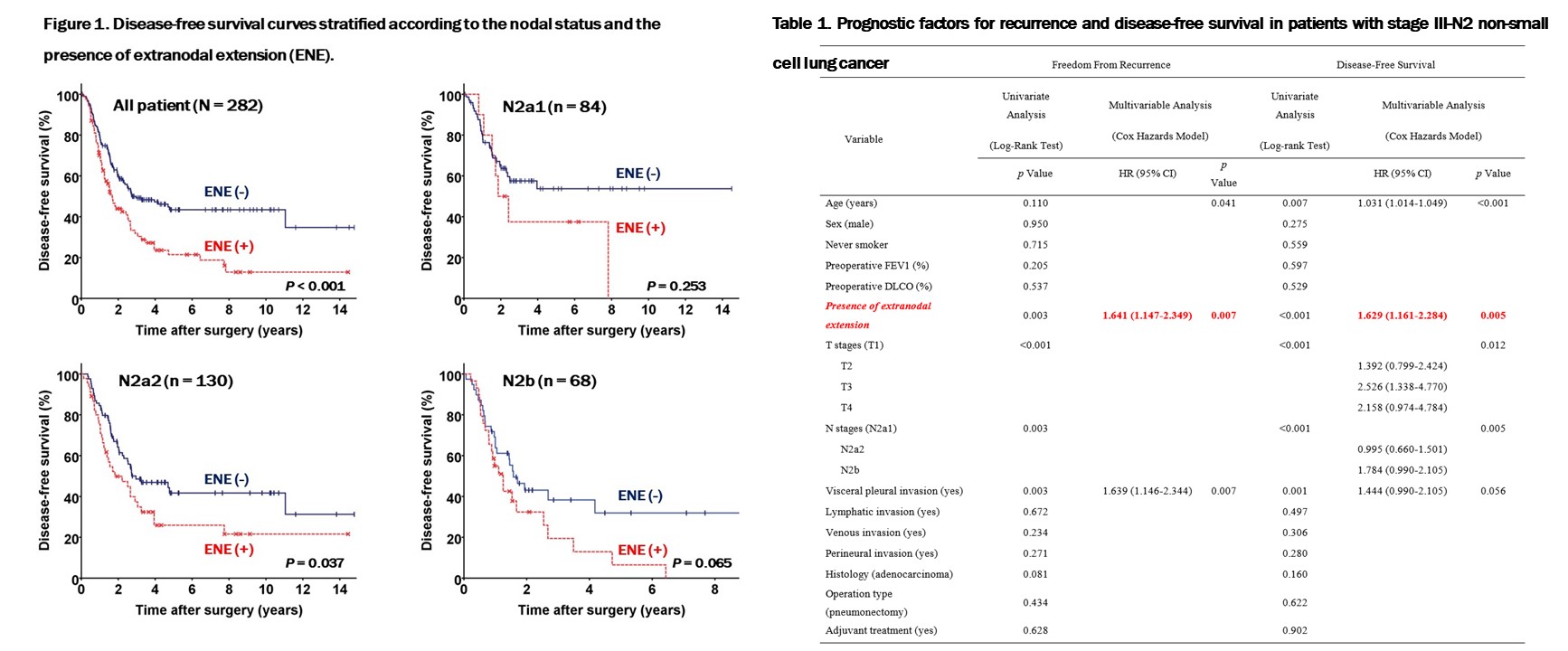초록접수 현황
| 20F-169 | 구연 발표 |
Prognostic Significance of the Extranodal Extension of Regional Lymph Nodes in Stage III-N2 Non-Small-Cell Lung Cancer After Curative Resection
Beatrice Chia-Hui Shih, Jae Hyun Jeon, Soyoung Lee, Wan Jin Hwang, Woohyun Jung, Yoohwa Hwang, Sukki Cho, Kwhanmien Kim, Sanghoon Jheon
Department of Thoracic and Cardiovascular Surgery, Seoul National University Bundang Hospital, Seoul National University College of Medicine, Seoul, Republic of Korea
Purpose : Extranodal extension (ENE) of nodal metastasis is defined as the extension of metastatic cells through the nodal capsule into the perinodal tissue. This study assessed the prognostic significance of ENE in patients with stage III-N2 non-small cell lung cancer (NSCLC).
Methods : From January 2005 to December 2018, 371 patients were diagnosed with pathologic stage III-N2 disease. All patients underwent anatomic pulmonary resection with mediastinal lymph node dissection. After excluding 89 patients with preoperative chemotherapy, and incomplete resection, 282 patients were included in the analysis. Lymph nodes (LNs) were sectioned and stained with hematoxylin and eosin (H&E), and histological slides of metastatic nodes were reviewed by dedicated pathologist. Prognostic factors for disease-free survival (DFS) were investigated, including age, sex, operation type, pathologic T stage, nodal status, visceral pleural invasion, perioperative treatment, and presence of ENE.
Results : Among 282 patients, ENE was detected in 85 patients (30.1%). The presence of ENE was associated with advanced T stage (p = 0.034), advanced nodal status (p < 0.001), lymphatic invasion (p = 0.001), and pneumonectomy (p = 0.002). Multivariable analyses revealed that, old age (p < 0.001), advanced T stage (p = 0.012), advanced nodal status (p = 0.005), and ENE presence (p = 0.005) were significant independent prognostic factors for DFS. The 5-year DFS was 21.4% for patients with ENE and 43.4% for patients without ENE (p < 0.001).
Conclusion : Presence of ENE, coupled with TNM staging, could be important prognostic factors in patients with stage III-N2 NSCLC after curative resection.
Methods : From January 2005 to December 2018, 371 patients were diagnosed with pathologic stage III-N2 disease. All patients underwent anatomic pulmonary resection with mediastinal lymph node dissection. After excluding 89 patients with preoperative chemotherapy, and incomplete resection, 282 patients were included in the analysis. Lymph nodes (LNs) were sectioned and stained with hematoxylin and eosin (H&E), and histological slides of metastatic nodes were reviewed by dedicated pathologist. Prognostic factors for disease-free survival (DFS) were investigated, including age, sex, operation type, pathologic T stage, nodal status, visceral pleural invasion, perioperative treatment, and presence of ENE.
Results : Among 282 patients, ENE was detected in 85 patients (30.1%). The presence of ENE was associated with advanced T stage (p = 0.034), advanced nodal status (p < 0.001), lymphatic invasion (p = 0.001), and pneumonectomy (p = 0.002). Multivariable analyses revealed that, old age (p < 0.001), advanced T stage (p = 0.012), advanced nodal status (p = 0.005), and ENE presence (p = 0.005) were significant independent prognostic factors for DFS. The 5-year DFS was 21.4% for patients with ENE and 43.4% for patients without ENE (p < 0.001).
Conclusion : Presence of ENE, coupled with TNM staging, could be important prognostic factors in patients with stage III-N2 NSCLC after curative resection.

책임저자: Jae Hyun Jeon
Department of Thoracic and Cardiovascular Surgery, Seoul National University Bundang Hospital, Seoul National University College of Medicine, Seoul, Republic of Korea
발표자: Beatrice Chia-Hui Shih (시가혜), E-mail : beatriceshih@snubh.org


